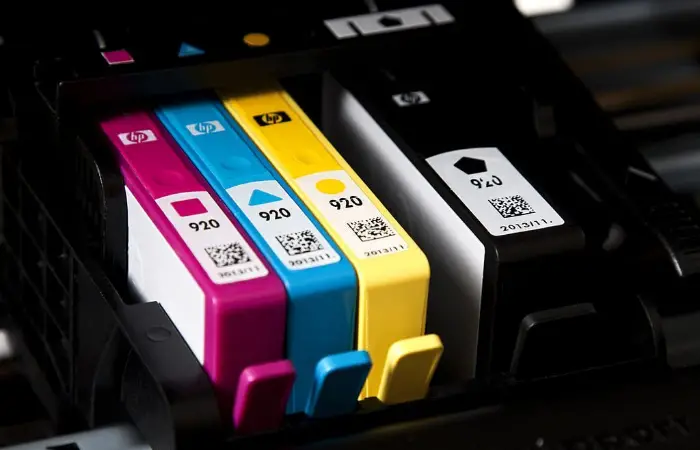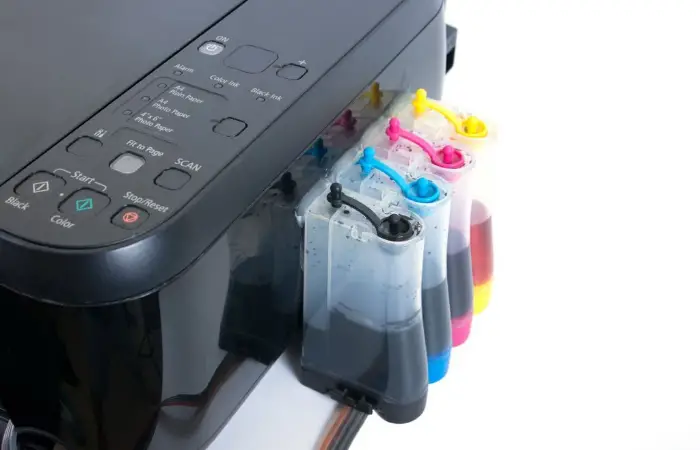Ink tanks and ink cartridges are both essential components of a printer, but they serve different purposes. Ink tanks hold more ink than cartridges and are refilled less often, making them ideal for high-volume printing. Cartridges, on the other hand, are smaller and require more frequent replacement.
Ink tanks vs ink cartridges: Which is right for you?
The answer to this question depends on your needs. If you do a lot of printing, an ink tank system may be a better investment since you won’t have to replace the tanks as often. However, if you don’t print very often, ink cartridges may be the way to go since they’re less expensive upfront.
What Is Ink Cartridge?
Most traditional inkjet printers use Ink cartridges. Ink cartridges are small, sealed plastic containers that house the ink used by your printer. Ink cartridges typically come in sets of three or four colors: cyan, yellow, magenta, and sometimes black. When one color of ink runs out, you must replace the entire cartridge.

What Is An Ink Tank?
Ink tanks are large reservoirs that hold a much higher volume of ink than traditional cartridges. Ink tanks are filled with ink at the factory and then installed in the printer. When an ink tank runs dry, you can simply refill it with more ink. Ink tanks are less expensive to maintain in the long run because you only need to purchase ink when you need it, rather than replacing entire cartridges.

Ink Tank Vs Ink Cartridge – Which One Is Better?
If you’re like most people, you probably think that ink tanks and ink cartridges are the same things. But they’re actually two different types of ink delivery systems, each with its own advantages and disadvantages.
Which one is better?
Ink tanks are large reservoirs that hold a considerable amount of ink. They’re typically used in commercial printing applications where high volumes of prints are required. Ink cartridges, on the other hand, are smaller containers that hold only a limited amount of ink. They’re more commonly used in home and office printers where print volumes are usually lower.
COST
Low running cost is one of the main advantages of ink tanks over cartridges. Ink cartridges need to be replaced more frequently than ink tanks, so they can end up costing you more in the long run. Ink tanks are also cheaper to refill than cartridges, so you’ll save money every time you need to top up your printer’s ink levels.
Compared to that, the printers that come with the ink cartridges tend to be cheaper than those that use ink tanks. So, if you’re looking for a budget printer, you might want to opt for an inkjet model that uses cartridges.
Ink cartridges usually tend to be more expensive than ink tanks when you look at the cost per page. This is because manufacturers sell ink cartridges at a higher price than you get them.
INK DRY ISSUE
Ink dry issue is the main difference between Ink tank and Ink cartridge. Ink dry issue is important to Ink cartridge users because when the ink in an Ink cartridge dries up, the Ink cartridge needs to be replaced. This can be costly, especially if you print a lot. Ink tanks don’t have this problem because they use a closed system that doesn’t allow the ink to dry out.
INK REFILLING ISSUE
While filling ink tank systems is fairly easy and can be done by anyone, it still poses a challenge. Ink cartridges cannot be refilled as they are designed in such a way that once the ink is finished you have to replace them. Ink tanks, on the other hand, can be refilled quite easily.
The only problem with ink tanks is that if not done carefully, air pockets might form inside the tank which could result in inconsistent printing quality. Ink cartridges do not have this problem as they come prefilled with ink from the factory itself.
PRINTING QUALITY
It might be surprising, but the printing quality between ink tanks and cartridges is identical. This is because the print heads in both types of printers are exactly the same.

The only difference lies in the amount of ink that’s available. Ink cartridges tend to have less ink than ink tanks, so if you print a lot, you might find yourself running out of ink more quickly with a cartridge printer.
This is where things start to get interesting. Ink cartridges typically have about 4-6ml of ink, while ink tanks can have up to 70ml. That’s a huge difference!
FAQS
Can I use an ink printer or an ink cartridge printer?
Yes, you can but it is not recommended. Ink cartridges are designed to be used with inkjet printers. Ink tanks are designed to be used with dye-sublimation printers.
Can I use an ink tank printer at home?
Yes, you can use an ink tank printer at home. Ink tank printers are designed for use in home and small office environments.
What is the difference between an ink cartridge and an ink tank?
Ink cartridges are designed to be used with inkjet printers. Ink tanks are designed to be used with dye sublimation printers. Ink cartridges contain a small amount of ink, whereas ink tanks hold a large amount of ink. Ink cartridges need to be replaced frequently.
Does an ink tank dry up?
yes, Ink tanks can dry up if left unused for long periods of time. Ink cartridges, on the other hand, are sealed and thus do not dry out.
Conclusion
In the end, it all comes down to your personal interests and corresponding needs. Printers with ink cartridges can be recommended to those with low printing needs due to low buying costs and fewer running costs. Ink tanks are ideal for office and high-volume printing as it cuts down on per-page costs. Ink tank printers have become increasingly popular in recent years due to their cost-effectiveness and versatility. Ink cartridges, on the other hand, have been the traditional choice for many users due to their convenience and ease of use.
I hope you find this article helpful if you have any questions please feel free to post in the comment section. Also, check out more interesting articles on our website.

I am Mark Luke and I’m the founder of PrinterBio.com. I started this site because I was tired of dealing with the problems that come with using printers. I wanted to help others avoid the time and frustration I had, So I started this site based on my own experience & what I’ve learned from other professionals. My goal is to help you find the right printer and easily solve any problems you may have with your printer.